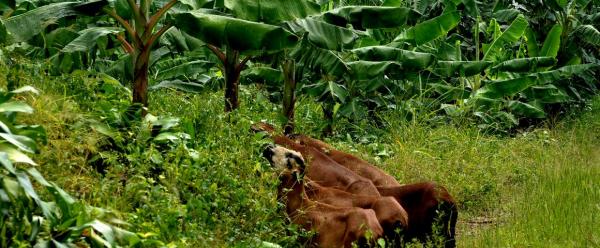Science at work 19 December 2025
- Home
- CIRAD news
- News
- MOOD, high-performance European health monitoring
Open source tools for high-performance European health monitoring

Covid-19 information board in a street in Jakarta, Indonesia © Ciradimage, A. Rival
What is the risk of a new pathogen entering Europe? What are the chances of it spreading? Where? The MOOD (MOnitoring Outbreak events for Disease surveillance in data science context) project set out to help detect, monitor and assess the epidemic risk for several diseases in Europe (see box).
MOOD, which is being coordinated by CIRAD under the EU H2020 programme, is associating 25 partners – research organizations, public health agencies and veterinary services – in 12 European countries over four years (2020-2024).
The partners are working on two fronts: research on the above questions (52 scientific articles published already) and the development of a health monitoring platform comprising three innovative modules. We take stock of progress at the halfway point.
Establishing the requirements of health agencies and veterinary services
The first step was to work with sociologists to pinpoint the practices and requirements of users working to detect and monitor diseases (health agencies, health monitoring bodies, disease control centres), and the problems encountered.
This revealed a need for simple visualization tools to track trends and situations in time and space, and for access to epidemiological and climate data, etc.
As a result, three complementary open source tools have been developed, to ensure that they are available either entirely free of charge or at a very low cost.
Improving monitoring
The first module is an ergonomic tool for visualizing health events, based on a global internet watch. "Using a wide range of information sources, the tool serves to visualize the appearance of a given disease or of clinical signs, to detect the early signs of disease emergence, including new and unknown diseases", MOOD project coordinator Elena Arsevska explains.
In late 2019, Chinese social media were already sharing information on the emergence of Covid-19. However, in a sea of other data, those weak signals were not detected in time by internet watch tools. Under the MOOD project, researchers conducted a retrospective analysis of those tools in the aim of making them better at detecting health information on the internet, notably by fine-tuning the vocabulary used depending on the stage of disease evolution.
This module is rooted in the PADI-web platform developed by CIRAD, and in ProMED, a complementary American tool. It covers plant, animal and human health, in several languages.
Visualising disease emergence variables
The second module will allow users to view on a map a wide range of data relating to disease emergence risk factors. For some types of data, it will operate almost in real time, at a resolution of up to 1 km. The data shown may be either environmental or epidemiological, for instance information on climate, avifauna or livestock farm distribution, water systems, temporary pools or infectious disease vector distribution.
This module will help epidemiologists and modellers to build monitoring programmes. It is being developed by Avia-GIS in Belgium, with a substantial contribution from the University of Oxford and the University of Southampton in the UK and Mundialis in Germany. It respects general data protection regulations as regards geo-localizable data (pseudo-anonymization).
Mapping the health risks posed by emerging diseases
The third module, unlike the first two, will be specific to each disease. It will generate emergence risk maps based on both informal data (from the first module) and formal data (from both the second module and official sources). For example, it will serve to determine the risk of West Nile virus occurring in Europe or that of the dengue virus being introduced into metropolitan France.
This module will serve to target disease monitoring more effectively and to anticipate emergence. It works using mathematical and statistical models specific to each disease.
This last module is intended for use by all health players involved in disease monitoring, be they epidemiologists or risk assessors in charge of monitoring programmes.
"For each of the three modules, we opted for an approach based on co-construction with users", Elena Arsevska stresses. "We hold quarterly monitoring meetings with all the partners to take stock and to reorient the development of these tools if necessary."
To guarantee the platform's future, a MOOD foundation is planned at the end of the project, in 2024. It will be devoted to maintaining, improving and disseminating the three modules.
• Covid-19 as a model for unknown pathogens (disease X), which are a challenge for any epidemic monitoring system;
• Influenza (all types of viruses), for airborne pathogens;
• Tick-borne encephalitis and Lyme disease, as models for endemic pathogens transmitted by endemic vectors;
• West Nile and Usutu viruses, as an example of exotic pathogens transmitted by endemic vectors;
• Chikungunya, dengue and Zika viruses, as models for exotic pathogens transmitted by invasive mosquito species;
• Tularaemia and leptospirosis, as models for neglected endemic pathogens with a range of modes of transmission and reservoirs;
• Antimicrobial-resistant bacterial strains, as models for complex, manmade disease threats.



























